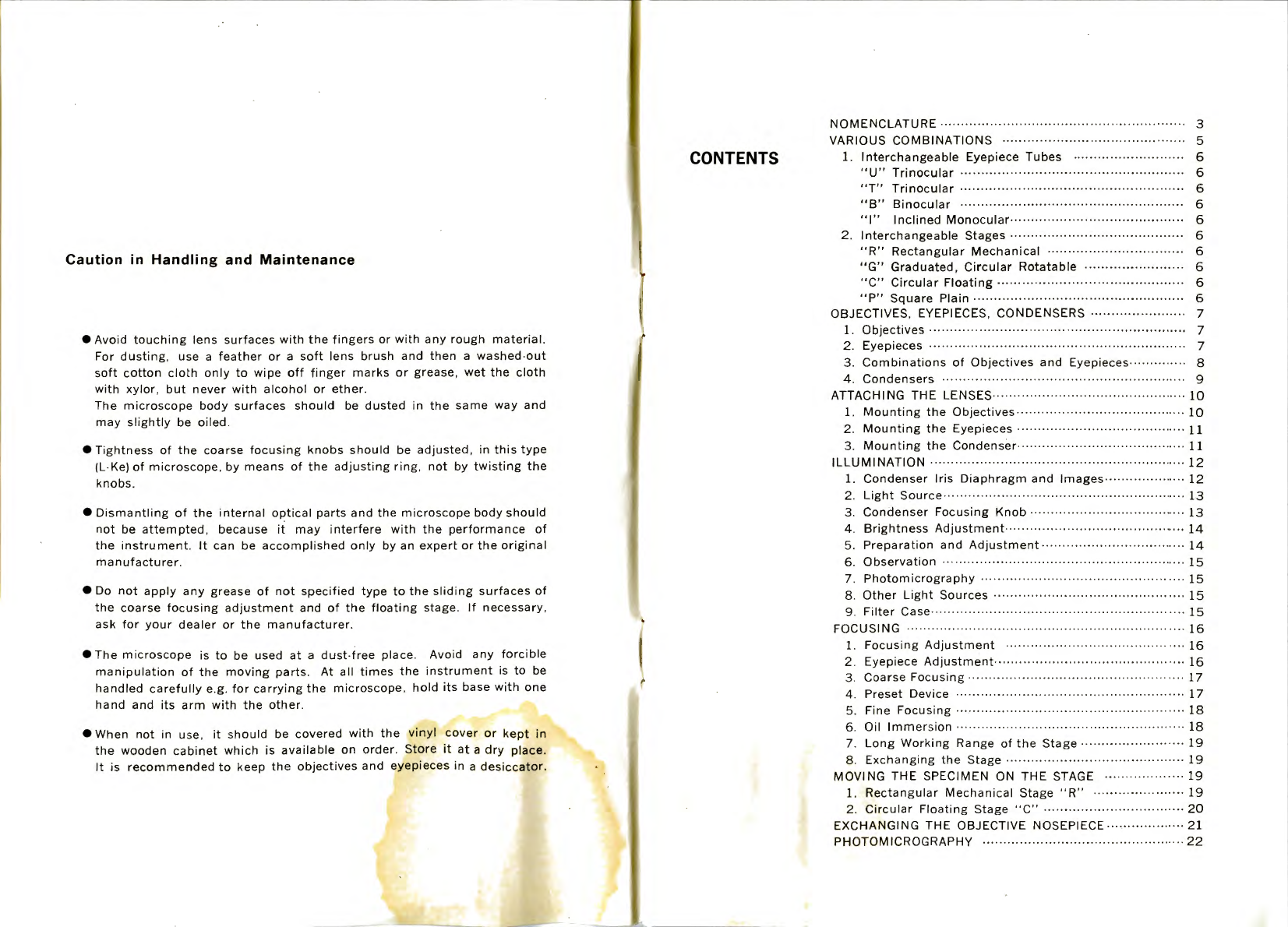
Caution
in Handling and Maintenance
• Avoid touching lens surfaces with the fingers or with any rough material.
For dusting, use a feather or a soft lens brush and then a washed-out
soft cotton cloth only to wipe off finger marks or grease, wet the cloth
with xylor, but never with alcohol or ether.
The microscope body surfaces should be dusted in the same way and
may slightly be oiled,
• Tightness of the coarse focusing knobs should be adjusted, in this type
(L-Ke) of microscope, by means of the adjusting
ring,
not by twisting the
knobs.
• Dismantling of the internal optical parts and the microscope body should
not be attempted, because it may interfere with the performance of
the instrument. It can be accomplished only by an expert or the original
manufacturer.
• Do not apply any grease of not specified type to the sliding surfaces of
the coarse focusing adjustment and of the floating stage. If necessary,
ask for your dealer or the manufacturer.
• The microscope is to be used at a dust-free place. Avoid any forcible
manipulation of the moving parts. At all times the instrument is to be
handled carefully e.g. for carrying the microscope, hold its base with one
hand and its arm with the other.
• When not in use, it should be covered with the vinyl cover or kept in
the wooden cabinet which is available on order. Store it at a dry place.
It is recommended to keep the objectives and eyepieces in a desiccator.
NOMENCLATURE 3
VARIOUS COMBINATIONS 5
CONTENTS
1- Interchangeable Eyepiece Tubes 6
"U"
Trinocular 6
"T"
Trinocular 6
"B"
Binocular 6
"1"
Inclined Monocular 6
2.
Interchangeable Stages 6
"R"
Rectangular Mechanical 6
"G"
Graduated, Circular Rotatable 6
"C"
Circular Floating 6
"P"
Square Plain 6
OBJECTIVES, EYEPIECES, CONDENSERS 7
1.
Objectives 7
2.
Eyepieces 7
3. Combinations of Objectives and Eyepieces 8
4.
Condensers 9
ATTACHING THE LENSES 10
1.
Mounting the Objectives 10
2.
Mounting the Eyepieces 11
3. Mounting the Condenser 11
ILLUMINATION 12
1.
Condenser Iris Diaphragm and Images 12
2.
Light Source 13
3. Condenser Focusing Knob 13
4.
Brightness Adjustment 14
5. Preparation and Adjustment 14
6. Observation 15
7. Photomicrography 15
8. Other Light Sources 15
9. Filter Case 15
FOCUSING 16
1.
Focusing Adjustment 16
2.
Eyepiece Adjustment 16
3. Coarse Focusing 17
4.
Preset Device 17
5. Fine Focusing ••• 18
6. Oil Immersion 18
7. Long Working Range of the Stage 19
8. Exchanging the Stage 19
MOVING THE SPECIMEN ON THE STAGE 19
1.
Rectangular Mechanical Stage "R" 19
2.
Circular Floating Stage "C" 20
EXCHANGING THE OBJECTIVE NOSEPIECE •••• 21
PHOTOMICROGRAPHY ••22















